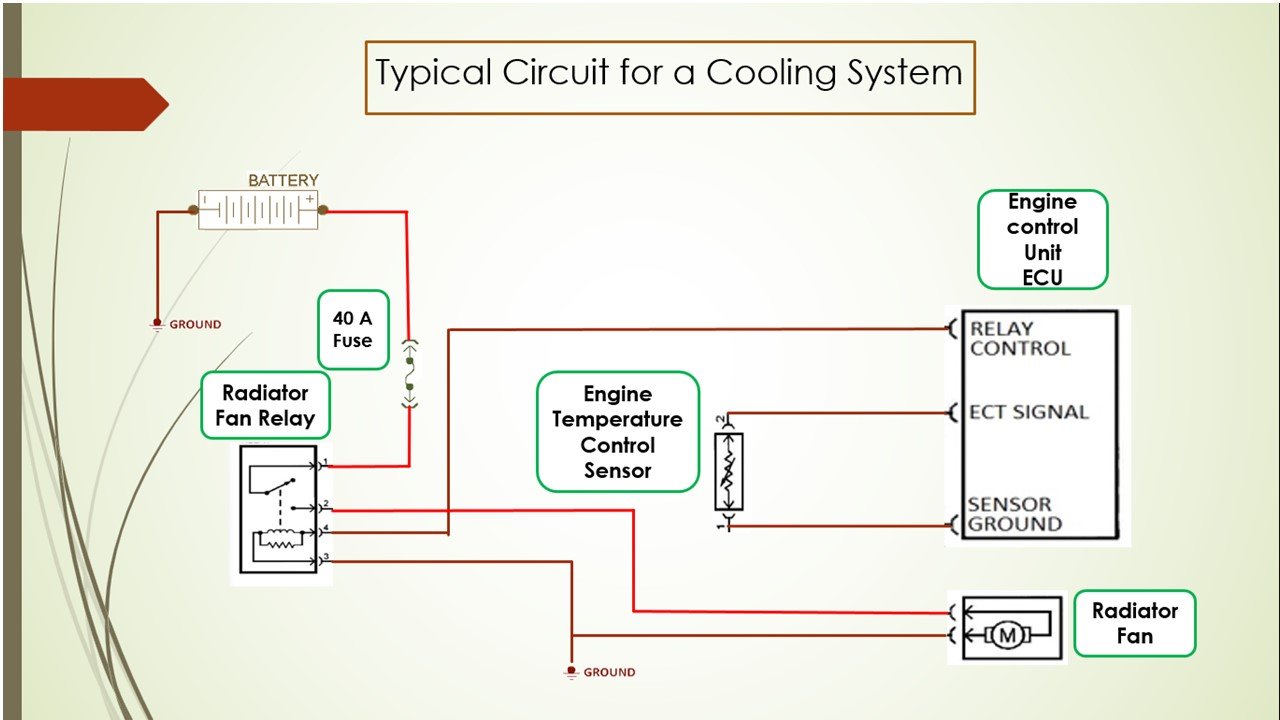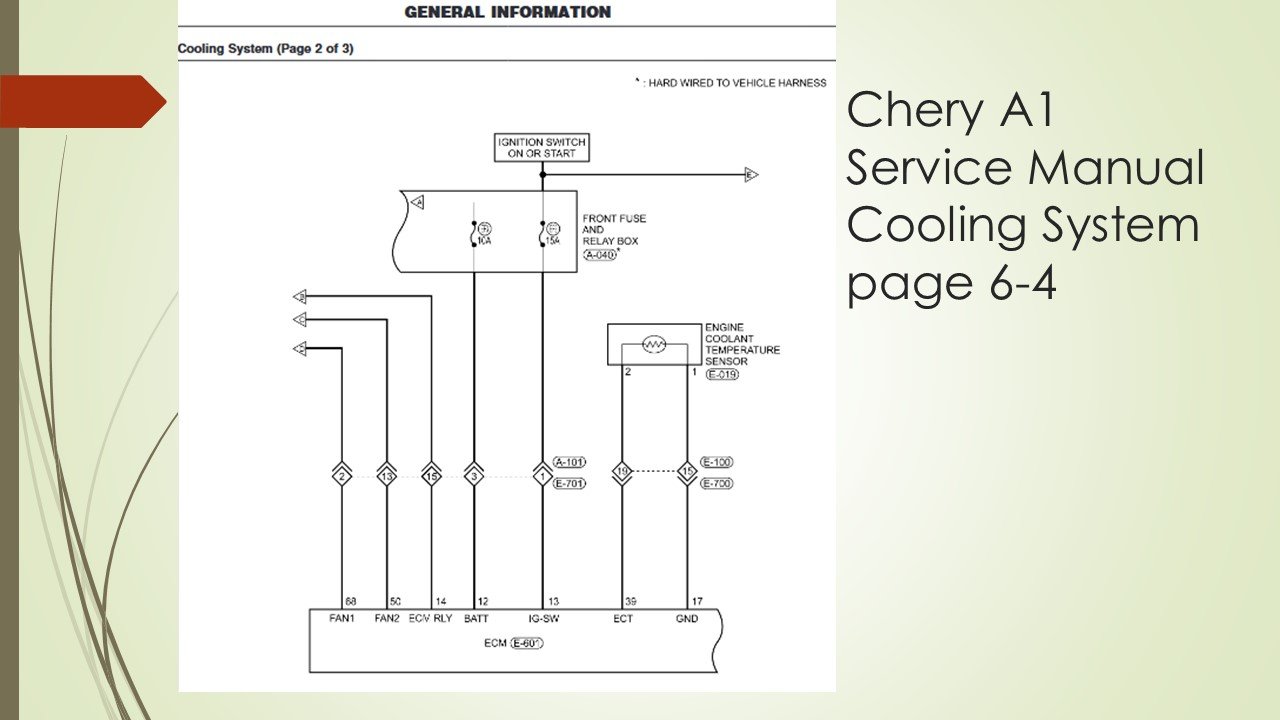Few days back when talking to a friend about his Ford Fiesta 1.6 lt 4-cylinder engine of his car., he mentioned that he was kind of worry because he did not see that the electric radiator fan came on even when he had the engine running for more than 30 min. He also said that the technician had told him that the computer would do so when the engine coolant got to the appropriate temperature.
Hace unos días, hablando con un amigo sobre el motor de su vehiculo Ford Fiesta 1.6 lt, motor de 4 cilindros, mencionó que estaba algo preocupado porque no veía que el ventilador eléctrico del radiador se encendiera incluso cuando tenía el motor en marcha durante más de 30 minutos. También dijo que el técnico le había dicho que el computador lo haría cuando el refrigerante del motor llegara a la temperatura adecuada.

Car Radiator / Radiador de Vehiculo
Not being an expert on the subject, though I enjoy looking for explanations to those comments from technicians since more than often they say whatever come to their minds just to get by or make an impression on whoever could happen to be listening to or hearing them talking.
My friend also said that he was told by the technician to disconnect the temperature sensor of the engine and that would make the fan come on. Doing it that way, my friend would know that everything was functioning properly. When I heard that, I asked this friend of mine what the technician was referring to. His answer was: “You know I am a painter, I would not understand anything of what he could tell me about any circuit to get the radiator fan working”. To that I replied, “So, Am I to understand that though I am not a painter by profession as you are, I would not try to understand any explanation you could give me to repair or do maintenance on the walls of my house?
The way I see it, it is a matter of trying to get even a slight knowledge about something to which you entrust your life, as you do when driving a car, or probably not wanting to come out of your circle of comfort.
Anyhow, though it was not my direct concern, I decided to investigate a bit about that particular topic by myself, not necessarily applied directly to that make of car, but to one that I am more familiar with. I understand car makers use the same concepts about car systems, though they may apply them with some differences.
When it comes to a Cooling System though not being an expert, the first thing that came to my mind was to draw a circuit myself, the way I think it is conceived.
Sin ser un experto en el tema, aunque me gusta buscar explicaciones a esos comentarios de los técnicos ya que más de una vez dicen lo que se les ocurre sólo para salir del paso o impresionar a quien pueda estar escuchando u oyéndoles hablar.
Mi amigo también dijo que el técnico le dijo que desconectara el sensor de temperatura del motor y que eso haría que el ventilador se encendiera. Haciendo eso, mi amigo sabría que todo estaba funcionando correctamente. Cuando escuché eso, le pregunté a este amigo a qué se refería el técnico. Su respuesta fue: "Ya sabes que soy es pintor, no entendería nada de lo que me pudiera decir sobre cualquier circuito para hacer funcionar el ventilador del radiador". A eso le contesté: "Entonces, ¿debo entender que aunque no soy pintor de profesión como tú, no trataría de entender alguna explicación que me pudieras dar para reparar o hacer el mantenimiento a las paredes de mi casa?
A mi modo de ver, se trata de intentar tener un mínimo conocimiento sobre algo a lo que confías tu vida, como cuando conduces un vehículo, o tal vez no quieres salir de tu círculo de confort.
De todos modos, aunque no era mi preocupación directa, decidí investigar un poco sobre ese tema en particular por mí mismo, no necesariamente aplicado directamente a esa marca de vehículo, sino a una con la que estoy más familiarizado. Tengo entendido que los fabricantes de automóviles utilizan los mismos conceptos sobre los sistemas de los carros, aunque pueden aplicarlos con algunas diferencias.
Cuando se trata de un sistema de refrigeración, aunque no soy un experto, lo primero que se me ocurrió fue dibujar un circuito yo mismo, de la forma en que creo que está concebido.

My Electric Circuit for a Cooling System / Mi Circuito Electrico para el Sistema de Refrigeracion
Conceptually, radiator electric fans should come on when the engine temperature reaches certain value. For that to take place, looking at the previous circuit, the Engine Control Unit or ECU, receives the signal from the Engine Temperature Control Sensor, or ETC, so that the ECU provides 12 V to the Radiator Fan Relay, which in turn, once energized, supplies 12 V to the Radiator Fan (motor).
This is well to know. However, since coolant is what should take the heat away from the engine, it is a mixture of water, antifreeze and some other ingredients to keep the cooling galleries cleaned and with the least possible rust. Whatever make is found in the market, ACDelco for General Motors, Radiox Premium for Toyota or any other kind, the coolant is in a high percentage made of water, and the latter boils at 100 °C approximately, therefore the radiator fan should come on just before the coolant reaches that temperature.
Conceptualmente, los electroventiladores del radiador deben encenderse cuando la temperatura del motor alcanza un determinado valor. Para que eso ocurra, mirando el circuito anterior, la Unidad de Control del Motor o ECU, recibe la señal del Sensor de Control de Temperatura del Motor, o ETC, para que la ECU suministre 12 V al Relé del Ventilador del Radiador, que a su vez, una vez energizado, suministra 12 V al Ventilador del Radiador (motor).
Esto es bueno saberlo. Sin embargo, como el refrigerante es lo que debe extraer el calor del motor, es una mezcla de agua, anticongelante y algunos otros ingredientes para mantener las galerías de refrigeración limpias y con la menor oxidación posible. Sea cual sea la marca que se encuentre en el mercado, ACDelco para General Motors, Radiox Premium para Toyota o cualquier otra, el refrigerante está compuesto en un alto porcentaje por agua, y ésta hierve a 100 °C aproximadamente, por lo que el ventilador del radiador debe encenderse justo antes de que el refrigerante alcance esa temperatura.

ACDelco Coolant / Refrigerante ACDelco
Once we understand that, it sounds reasonable that the temperature sensor is to tell the Engine Control Unit or ECU what the temperature is at any moment, in other words, the ECU keeps monitoring the coolant temperature all the time. How the ECU does it is a matter of my next post.
A question arises about what type of sensor it is, what it looks like and what its main electrical feature should be. One thing is for sure, it is not an “On and Off” device, like a switch because it should send a signal along certain temperature range. One device that does so is a thermistor. As the temperature it is exposed to changes, its resistance does the same accordingly. In the Chery A1 Service Manual, page 6-4, a similar circuit to the one I drew previously, is shown, for a Chery Face.
Una vez que entendemos eso, suena razonable que el sensor de temperatura es para decirle a la Unidad de Control del Motor o ECU cuál es la temperatura en cualquier momento, en otras palabras, la ECU sigue monitoreando la temperatura del refrigerante todo el tiempo. Cómo lo hace la ECU es cuestión de mi próximo post.
La pregunta que surge es qué tipo de sensor es, fisicamente cómo es y cuál debe ser su principal característica eléctrica. Una cosa es segura, no es un dispositivo de "encendido y apagado", como un interruptor porque debe enviar una señal a lo largo de cierto rango de temperatura. Un dispositivo que lo hace es un termistor. A medida que la temperatura a la que se expone cambia, su resistencia hace lo mismo en consecuencia. En el Manual de Servicio del Chery A1, página 6-4, se muestra en parte, un circuito similar al que dibujé anteriormente, para un Chery Face.

Chery Face / Vehiculo Chery Modelo Face

Source
Let us understand what my friend’s technician meant when he said that for the radiator fan to come on, the temperature sensor has to be disconnected. If the sensor changes its resistance, considering when it is disconnected from the engine’s computer, means that the computer sees an open circuit or a very high resistance. From that I would correlate that the sensor must be such that for high temperature of the engine, it would send a high resistance signal. In other words, It must be what is called a Positive Temperature Coefficient Sensor, PTC. How about if the sensor is a Negative Temperature Coefficient Sensor, NTC, the type of sensor that for high temperature they would output a low resistance signal and for low temperature they would output very high resistance signal. If the last was the case, then the radiator fan would not come on “at all” because the ECU would interpret it as a cold engine.
Entendamos lo que quiso decir el técnico de mi amigo cuando dijo que para que el ventilador del radiador se encienda, el sensor de temperatura tiene que estar desconectado. Si el sensor cambia su resistencia, teniendo en cuenta cuando está desconectado del computador del motor, significa que el computador ve un circuito abierto o una resistencia muy alta. De eso yo correlacionaría que el sensor debe ser tal que para alta temperatura del motor, enviaría una señal de alta resistencia. En otras palabras, debe ser lo que se llama un sensor de Coeficiente de Temperatura Positivo, PTC. Que tla si el sensor es un Sensor de Coeficiente de Temperatura Negativo, NTC, el tipo de sensor que para alta temperatura emitiría una señal de baja resistencia y para baja temperatura emitiría una señal de muy alta resistencia. Si el último fuera el caso, entonces el ventilador del radiador no se encendería "en absoluto" porque la ECU lo interpretaría como un motor frío.
By this short analysis, that test would not work if we do not know the type of temperature sensor that is mounted on our car’s engine. And honestly, whether it is a PTC or an NTC, by looking at them one cannot tell the difference.
Sensors may differ from each other by the number of wire they have, some may have 3 wires, though most of them would only have 2 wires, as in the case of a Chery Face or A1 model
Según este breve análisis, esa prueba no funcionaría si no conocemos el tipo de sensor de temperatura que está montado en el motor de nuestro automóvil. Y sinceramente, si es un PTC o un NTC, con sólo mirarlos no se puede diferenciar.
Los sensores pueden diferenciarse entre sí por el número de cables que tienen, algunos pueden tener 3 cables, aunque la mayoría sólo tendrían 2 cables, como en el caso del modelo Chery Face o A1

Coolant Engine Temperature Control Sensor / Sensor de Control de Temperatura del Refrigerante del Motor
So, we would be better of by understanding how things work before taking any actions.
Por lo tanto, estaríamos mejor si entendemos cómo funciona|n las cosas antes de tomar cualquier acción.
All pictures are of my own
